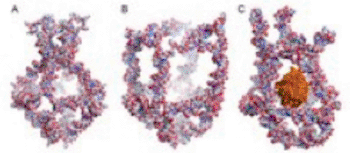Nanorobots Designed for Drug Delivery
By LabMedica International staff writers
Posted on 16 Dec 2013
Initial phases of research have been started towards developing a nanorobot that in the long run will enable the targeted transport of pharmaceutical agents in the body.Posted on 16 Dec 2013
In collaboration with American and Italian colleagues, researchers from Aarhus University (Aarhus, Denmark) have now taken a major move towards developing a nanorobot that will enable the targeted transport of medications in the body.

Image: The figure shows a nanocage in which eight unique DNA molecules are mixed together. The nanocage has four functional elements that transform themselves in response to changes in the surrounding temperature. These transformations either close (1A) or open (1B) the nanocage. By exploiting the temperature changes in the surroundings, the researchers trapped an active enzyme called horseradish peroxidase (HRP) in the nanocage (1C) (Photo courtesy of Sissel Juul).
A nanorobot is a trendy term for molecules with a unique feature that enables them to be programmed to perform a specific task. In collaboration with colleagues in Italy and the United States, researchers at Aarhus University have now taken a major step towards building the first nanorobot of DNA molecules that can encapsulate and release active biomolecules.
The nanorobot (also known as a DNA nanocage) will eventually be used to transport drugs throughout the body and thereby have a targeted effect on diseased cells. Using DNA self-assembly, the researchers designed eight unique DNA molecules from the body’s own natural molecules. When these molecules are combined, they spontaneously aggregate in a usable form, the nanocage.
The nanocage has four functional components that transform themselves in response to changes in the surrounding temperature. These transformations either close or open the nanocage. By exploiting the temperature alterations in the environment, the researchers encapsulated an active enzyme called horseradish peroxidase (HRP) in the nanocage. They used HRP as a model because its activity is easy to trace.
This is possible because the nanocage’s outer lattice has apertures with a smaller diameter than the central spherical cavity. This structure makes it possible to encapsulate enzymes or other molecules that are larger than the apertures in the lattice, but smaller than the central cavity.
The researchers published their findings November 26, 2013, in the journal ACS Nano. The researchers demonstrated in their article how they could exploit temperature changes to open the nanocage and allow HRP to be encapsulated before it closes again. They also show that HRP retains its enzyme activity inside the nanocage and converts substrate molecules that are small enough to penetrate the nanocage to products inside.
The encapsulation of HRP in the nanocage is reversible, in such a way that the nanocage is capable of releasing the HRP once more in reaction to temperature changes. The researchers also show that the DNA nanocage with its enzyme load can be taken up by cells in culture. Looking towards the future, the idea behind this nanocage is expected to be used for drug delivery, i.e., as a means of transport for medicine that can target diseased cells in the body in order to achieve a more rapid and more beneficial effect.
The research was performed at the department of molecular biology and genetics and the Interdisciplinary Nanoscience Centre (iNANO) at Aaruhus, Aarhus University, in collaboration with researchers from Duke University (Durham, NC, USA) and the University of Rome (Italy).
Related Links:
Aarhus University
Duke University
University of Rome














